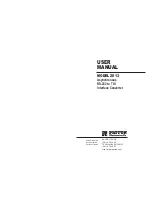
A-TS
39
https://a-ts.cn/en/
3 ) If P1.10 is set to 2, Acc time ( P0.12 ) and Dec time ( P0.13 )
should be set correctly and remove the load from the motor and check
the safety;
4 ) Set P1.10 to 1 or 2, press FUNC/DATA, and then press RUN to start
auto-tuning;
5 ) When the operating LED turns off, that means the auto-tuning is over.
Note
:
1
.
When setting P1.10 to 2, you may increase Acc/Dec time if over-current or
over-voltage fault occurs in the auto-tuning process;
2
.
When setting P1.10 to 2, the motor load must be removed before starting
rotating auto-tuning;
3
.
The motor must be in standstill status before starting the auto-tuning, otherwise
the auto-tuning cannot be executed normally;
4
.
If it is inconvenient to start auto-tuning ( e.g. the motor cannot break away from
the load )
, or you don’t require much on motor control performance, you can use
stationary auto-tuning or even disable the function. You may input the values on
the motor nameplate correctly ( P1.01~P1.03 ) ;
5
.
If the auto-tuning function is unavailable and there is motor parameters on the
nameplate, you should input the values correctly ( P1.01~P1.03 ) , and then input
the calculated values ( P1.04~P1.08 ) . Please set the parameters correctly;
6
.
If auto-tuning is not successful, the inverter alarms and displays fault F.tU.
7.3 Start/Brake Parameter ( P2 )
P2.00 Reserved
Reserved
P2.01 Start frequency
Range: 0.20
~
60.00Hz
【
0.50Hz
】
P2.02 Start frequency hold time
Range: 0.0
~
10.0s
【
0.0s
】
Start frequency refers the frequency at which the inverter starts, as
shown in Figure 7-3 as f
S.
Start frequency hold time refers the time within
which the inverter runs at start frequency during start up, as shown in
Figure 7-3 t
1:
















































